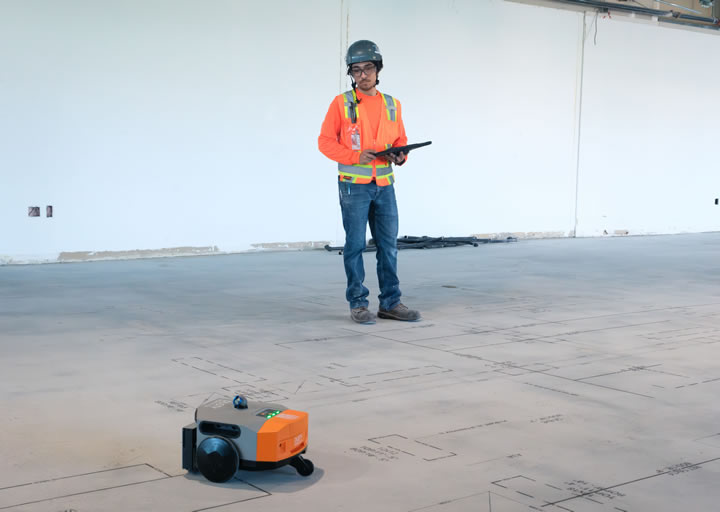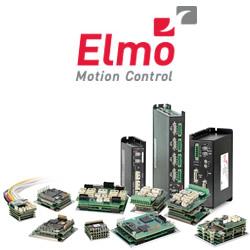What made Hexagon the right partner was their deep expertise in precision measurement and their willingness to collaborate on adapting their metrology solutions for the demanding conditions of construction sites.
 Moving Construction from Digital Design to Physical Reality
Moving Construction from Digital Design to Physical Reality

Q&A with Phil Herget, Co-Founder and CTO | Dusty Robotics
Tell us a little about Dusty Robotics.
Dusty Robotics is transforming how construction projects move from digital design to physical reality so that what you design is what you build. We've developed an automated layout system that combines robotics, precision measurement technology, and AI to print building plans directly onto jobsite floors with 1/16" accuracy. Our FieldPrint platform takes information from Revit or AutoCAD models and marks out exactly where walls, MEP systems, and other building elements should be installed.
Since our founding, we've enabled contractors to print more than 200 million square feet of layout across thousands of buildings. We work with leading general contractors like Mortenson, McCarthy, and Skanska, as well as trade contractors across framing, mechanical, electrical, and plumbing. Our mission is to ensure design integrity in the field through a seamless file-to-field process that connects design teams with field crews, improving collaboration and ensuring that what's built matches what was designed.
Tell us about the partnership with Hexagon Manufacturing Intelligence and what brought the companies together.
Our partnership with Hexagon has been foundational to Dusty's success. Hexagon believed in our vision from the earliest stages. They have a fantastic team that was willing to work with and support us when we were getting started. This isn't always the case for earlier-stage startups bringing manufacturing-grade precision to an industry that hasn't traditionally operated at that level.
What made Hexagon the right partner was their deep expertise in precision measurement and their willingness to collaborate on adapting their metrology solutions for the demanding conditions of construction sites. Their Leica laser trackers provide the accuracy foundation that makes our system viable for mission-critical projects like data centers, healthcare facilities, and advanced manufacturing buildings, where precision is non-negotiable.

What led Dusty to look beyond traditional construction tools and explore metrology-grade systems like Hexagon’s Leica Absolute Trackers, which are typically used in large-scale manufacturing?
We had a vision of not just performing layout, but elevating how the construction industry communicates information from design to field across multiple trades. Traditional construction tools, such as total stations, couldn't deliver what we needed to make that vision a reality. Hexagon helps enable us to have a much more strategic conversation with general contractors that goes far beyond just automated layout.
Because we eliminate things like rework, which saves time and speeds up value projects get completed faster with better outcomes. The precision of Hexagon's system enables this by allowing us to print a more intricate layout and align multiple swaths printed from multiple directions. All of these capabilities are essential to our vision of creating a true file-to-field communication platform, not just a layout tool.
Without metrology-grade precision, we'd be limited. With it, we can transform the floor into an information-rich interface that helps crews understand not just where things go, but how they connect to the broader project.
How has integrating Hexagon’s technology changed Dusty’s product roadmap or vision for what automated layout can achieve on construction sites?
The precision and speed of Hexagon's tracking systems have helped us to unlock some interesting features that construction teams in the field have really run with on their own.
For example, our QR code printing capability relies on millimeter-level precision to ensure codes are scannable and accurately linked to specific locations. We can also print points and stud locations dynamically as the robot is moving, rather than stopping at each point, which dramatically increases productivity. Beyond layout, we've been able to expand into floor elevation mapping, where teams can measure flatness and floor deviations with the efficiency required for mission-critical applications in healthcare and industrial settings.The accuracy and reliability of Hexagon's technology has given us confidence to think bigger about what's possible.
This partnership essentially created an entirely new category: automated construction layout. How has the industry responded so far? Any feedback from customers?
The response has been remarkable. You can find customer stories with ROI data here and see the latest social posts from real Dusty Robotics users across the built world here. We've seen adoption across general contractors, specialty trades and industrial manufacturing owners, which tells us we're solving a real pain point. Contractors consistently tell us about the time savings. What used to take days of manual layout work now takes hours. Equally important is the confidence these workers gain. We’re providing additional context to what should be build which helps you eliminate the rework and coordination issues that are common on jobsites.
We're also hearing that the file-to-field connection is changing team dynamics. Field crews can trust that what's printed matches the latest design, and when changes happen, we can quickly update the floor to reflect them. This reduces friction between the office and the field. The adoption curve has been strong enough that we've now printed over 200 million square feet across thousands of buildings.
Looking ahead, how do you see the integration of the newer Leica AT500 changing the user experience and capabilities for contractors in the field?
The AT500 represents a significant step forward in making our system more practical for everyday construction conditions. The integrated hot-swappable batteries, short startup time, and better portability ensures this tracker is easy to set up and move around the site. For our customers, that translates directly into productivity.
More importantly, these improvements enable our customers to work in more complex and smaller spaces where multiple setups are required. And these environments change physically, by the hour, so this is truly helpful. We're seeing demand for single-family homes, areas where materials are already loaded or crews are actively working, and finished floors inside individual rooms. The AT500's 320-meter measurement volume, combined with its IP54 rating for dust and water protection, means contractors can use our system confidently across a wider range of project types and conditions.
Philipp Herget is a seasoned engineer, scientist, and entrepreneur with over 13 years of diverse experience in engineering, particularly in hardware development. As the Founder and CTO of Dusty Robotics, he leads innovative projects that integrate technology with business strategies, focusing on creating simple yet effective solutions. His extensive background includes leading engineering teams at Savioke, where he was instrumental in developing advanced robotics systems. Philipp's work spans various industries, including residential construction and industrial machinery, showcasing his adaptability and broad skill set. He is a prolific inventor with more than 30 patents, reflecting his commitment to innovation. His educational background includes a PhD from Carnegie Mellon University, where he specialized in electrical and computer engineering, as well as a BS from Worcester Polytechnic Institute. Philipp's passion for engineering is matched by his belief in the power of creativity in problem-solving.
The content & opinions in this article are the author’s and do not necessarily represent the views of RoboticsTomorrow
Featured Product

